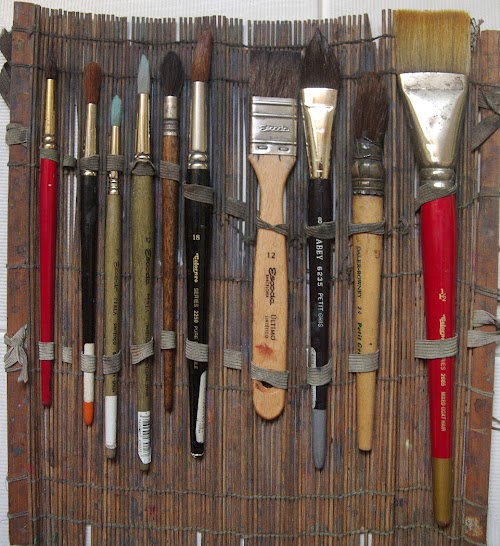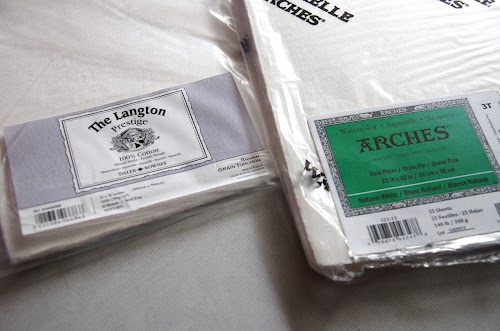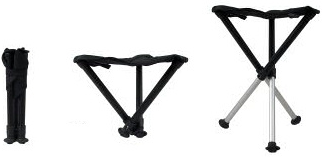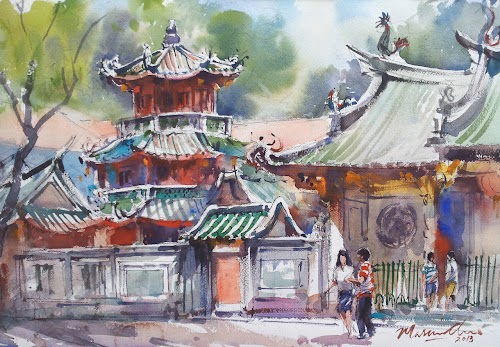Art Tools of Marvin Chew
Marvin Chew's a full time watercolour artist located in Singapore. I've known him for a few years now, from the Urban Sketcher Singapore Group. He's also the vice president of Singapore Watercolour Society and regularly organises outdoor painting sessions for the community and his students.
Over the years, he has amassed quite a huge amount of tools. I've never taken a closer look until now. So let's look at them.

This is the plein air set: assortment of brushes in bamboo mat, hand-made Craig Young paint box, paint tubes in zip bag, SLIK Sprint Mini tripod converted into portable easel, Walkstool, corrugated board.

A close up look at the brushes from left to right:
- Alvaro Castagnet needlepoint No.8
- Raphael Kolinsky 8404 No.8
- Escoda Perla No.8
- Escoda Perla No.12
- Escoda Ultimo Mop No.10
- Colorpro Red Sable 2250 No.18
- Escoda Ultimo Flat No.12
- Isabey Cat's Tongue No.8
- Daley Rowney 24 Mop No.7
- Colorpro Flat 2885 No.1 1/2
Qn: Can you talk about the set of brushes you're using now? What are the characteristics of each? Which one do you use most often?
Well, I bring these with me when I go out to paint on location/plein air. I have another set of brushes which I kept in the studio for larger works but they are similar brushes to these, only larger. Let's break them down into the different types:
Needlepoint Brush - Endorsed by watercolour master Alvaro Castagnet, it is a liner with a fat belly to store paints and a long fine needle-like point (hence the name). Useful to paint wires, cables, cloth lines, etc.
Round Sable Brush - As you can see, I use many round brushes. 2 of them are made of natural sable hairs. Colorpro Red Sable No.18 is the largest round brush I have. It's my "workhorse", using it most of the time in any painting I do, due to its superb absorbency and still able to hold its shape after every brushstroke. Raphael Kolinsky Sable 8404 No.8 has the same function but smaller. I used to have a No.12 of this brush, but Kolinsky sable is very expensive and with the rigorous punishment I meted out to my brushes with the way I paint (lots of dry brush techniques), I have since wore out the sharp point, so I switched to the more economical Colorpro Red Sable.
Round Synthetic Brush - Esoda Perla White Toray No.8 and No.12 are my two other must-haves apart from my "workhorse". They are recommended by Joseph Zbukvic whom many consider to be one of the best living watercolourists at the moment. The brush loads quite a fair amount of paints for a non-natural hair brush as Toray White is one of the softest synthetic hairs. It has good tension that springs back to its original shape every time. With its super fine point, I use it to "draw" details and add finishing touches to my painting.
Flat Brush - I have 2 of them. Colorpro Flat No. 1 1/2 is a big flat brush made of mixed goat hair. Useful for laying in flat even wash. Due to its huge size, when I need to pre-wet the paper with clear water, I'll use this. Escoda Ultimo Flat No.12 is made of synthetic hairs and serve the same purpose but for smaller area.
Cat's Tongue - Recently acquired, it is made of squirrel hairs too but is more versatile than a mop due to its wide bottom and curvy pointed tip, great for laying washes using the wider side of the brush and cutting into tight corners using the pointed tip.
Mop Brush - I have 2 here. Daley Rowney 24 Mop No.7 is made of squirrel hairs - very soft and loads a great deal of paints and waters. It is perfect for laying down washes for big areas. The other one, Escoda Ultimo Mop No.10, a gift from Internationally acclaimed floral watercolour artist Fabio Cembranelli when he visited Singapore last year. It is actually made of synthetic hair but is equally capable of holding paints but due to its smaller size, I only use it when doing smaller works (You'll soon notice that there's no standardised numbering system for brush size between different brush makers. For example, Daley Rowney's No.7 is actually much larger than Escoda's No.10)
Qn: Which is the most versatile brush?
It has to be the Colorpro Red Sable No.18 as I use it most of the time, for laying washes, glazing, wet on wet, wet on dry, dry brush, etc. I can even use it to paint some details even though it's a big brush due to the fine point it has, or rather used to have (I abused my equipment, LOL!).
Qn: For beginners getting watercolour brush, what consideration should they have? How should they choose? What would you recommend?
Affordability is usually the first concern considering good watercolour brushes can cost hundreds of dollars. For beginners who usually don't paint too big a painting, they can start with just 3 brushes - a mid-size mop brush for laying the initial washes, a red sable brush, probably a no.8 for general brush work and a fine point synthetic for adding details.

Craig Young's watercolour box
Qn: Craig Young's watercolour boxes are quite pricey. Why do you think artists are still willing to fork out the money to get it compared to other palettes?
Haha, it's hard to explain. Why do some people drive BMW when a Toyota will get you from Point A to B as well? As for me, I personally like hand-made stuff. There's an elegant feel to it that mass-produced merchandise will never have. Craig Young's boxes are the most beautifully hand-crafted palettes I've ever seen in the market. I'll like to think of it as my little "indulgence" for the sake of my art. Anyway, it costs about the same price as a high-end tennis racket but I don't play tennis, I paint, LOL!
More about Craig Young here: The Craig Young Experience (watercolourfanatic.blogspot.com)
Qn: I remember you use a few brands of watercolours. Which brand of watercolours do you prefer? Why?
Yes, over the years I have tried many brands of watercolours.
I use Lukas, Holbein, Schmincke, Winsor & Newton, Da Vinci, and most recently added Daniel Smith to the mix, all artist grade paints.
I don't have preference for any brand but rather I choose the colours that I like from different brands based on the pigment used, lightfastness, granulation effect, and of course, price. I paint almost daily, so I usually buy them in bigger tubes, 24ml or 37ml so I shop around online to find the best deals and promotions.
Qn: You seem to prefer watercolour tube compared to pans. Any reasons?
The colours are fresher and more moist when it's straight out of the tube.
They are also easier to mix in large amount as I need to cover quite a large area painting in half sheet (the usual size I paint outdoors). It will take me forever to mix a large quantity of colour using pans.
Also, pans may damage a good brush in the long run as you keep digging the pans to get the colours especially when it has dried up, but the same can be said of dried up paints from the tube.
Qn: What's your advice for beginners looking to buy watercolours? What should they look out for?
Avoid school watercolour set sold in stationery shops! They are made for children containing very little pigment and you'll struggle to get anything out of it and end up frustrated.
If budget is a concern, go for student grade paints made by professional paint makers such as Cotman by Winsor & Newton, Aquafine by Daley Rowney, Van Gogh by Talens, just to name a few.
You can then upgrade to Artist grade paints once you're comfortable mixing colours and master the basic painting techniques. Having said that, if budget isn't an issue, I'd advise you to go for the artist grade paints straight away. It took me only 2 months to make the switch when I was still a beginner after realising how vibrant, and beautiful the artist grade paints are!

Qn: These seem like single sheets of watercolour paper. What are the advantages of using single sheets compared to padded ones?
Yes, these are sheets of imperial size watercolour paper measuring 22" x 30" or approximately 56 x 76cm.
Obviously, the advantage of using sheets is that you have the option to cut them into whatever size you like.
In watercolour terms, you'll often see paintings done in quarter, half or full sheet. Buying single sheets are more economical than buying the same brand of papers in padded or block as the manufacturer will surely factor in material and labour cost to cut them and produce them in nice looking cover.
Blocks are also heavier especially when they are new. I'll usually bring only 2 or 3 half sheets with me during my plein air outings so they don't weight much.
Qn: Different artists prefer different brands of watercolour naturally. So why do you choose the Langton Prestige for Rough and the Arches for Cold Press?
These two are my current favourites. I use 100% cotton-made papers as they are more absorbent and colours mix better on them.
Arches watercolour papers are often regarded as the best in the market, very tough and durable, and great for all types of watercolour works.
Langton Prestige had similar properties but feels softer, and wet washes spread more freely on it.
Although watercolour papers are categorized into Hot Press, Cold Press and Rough texture, different manufacturers will categorise the coarseness of the paper texture differently. Langton Prestige's Rough is actually closer to Arches Cold Press in terms of texture coarseness. In fact, I will choose Rough for other brands such as Saunders Waterford, Fabriano Artistico but Arches Rough is much coarser than other brands, so I opt for Cold Press when using Arches.
Qn: Do you use Hot Press watercolour paper? Why?
I don't use Hot Press paper as it is too smooth for my painting style. I like to use granulating colours where larger particles in some pigments will sink into the grains of textured papers, creating beautiful grainy effect. I also do a lot of dry brush techniques so some degree of roughness on the paper is essential. Hot Press paper is more suited for very detailed works and for illustration.

Walkstool, SLIK Sprint Mini camera tripod converted to portable easel, and clipboard with camera tripod mount bracket attached.
Qn: What's the Walkstool?
Walkstool is a high quality Swedish-made portable stool. I have the 18 inch Comfort model, which has the same seating height of a normal dinning chair when the legs are extended. Previously, I used a small foldable stool where you're actually sitting in a squatting position. I've developed an aching back sitting in that low position. So, I bought the Walkstool to improve my posture while painting outdoors.

Qn: That easel looks like a DIY. How do you make an easel like that? How does the functional setup look like?
Oh yes, it is modified from a camera tripod SLIK Sprint Mini. I attach a camera tripod mounting bracket on the back of a used clipboard. It is then screwed onto the tripod head and secured at a reverse position, where it can hold a piece of corrugated board on which I tape my watercolour paper with masking tapes.
The whole set up look like this:


Marvin painting on the portable easel at Shaolin Temple in Luoyang, China

This is Marvin's urban sketching set:
- Leather bound sketchbook
- Fome metal pocket palette
-
- Faux leather pen pouch containing the following:
- Hero Calligraphy fountain pen 578
- Sailor Special Script Calligraphy fountain pen
- Bamboo dip pen
- Golden taklon flat brush
- Escoda Reserva Kolinsky-Tajmyr 1214 No.10 pocket travel brush
- Japanese brushpen loaded with black ink (now loaded with Noodlers bulletproof black ink)
- Holbein water brushpen
- Ashley Red Sable No.5 pocket travel brush
- Escoda Perla No.10
Qn: Urban sketching set? How's the selection different from your plein air set? Can you give us a run down on the tools? I noticed that the only common brush between the two sets is the Escoda Perla No.10.
For urban sketching, I try to keep everything to the bare essentials, and as light as possible. With just a sketchbook, a pocket sized palette and a couple of fountain pens and brushes, I'm good to go.
Fountain Pens - I have the Hero 578 which I use almost all the time, while the Sailor Special Script is my back-up pen as I find it too light. Both pens have the curved nib which mimic the calligraphy strokes of Chinese brush. You can vary the thickness by varying the angle you hold the pen at.
Bamboo dip pen - is made by the owner of Straits Art Co., and given to me as a sample. I have a bottle of Noodler's waterproof black ink in my bag to dip it with.
Golden Taklon flat brush - this is a cheap brush available at most stationery shop. I use it when I want to paint more squarish shapes, but frankly speaking, I can't remember the last time I use it!
Holbein water brushpen - It has a nylon brush with reservoir on the handle to store clear water. A quicker alternative than traditional brushes but I don't really like the stiff nylon hair and controlling the water flow can be tricky.
Japanese ink brushpen - similar to the water brushpen, but loaded with black ink. Sometimes I'd sketch directly using this, resulting in a more oriental Chinese ink painting style. I also use this to spread black ink on dark areas of my sketches.
Escoda Reserva Kolinsky-Tajmyr 1214 No.10 - this is a collapsible pocket travel brush made of kolinsky sable hair. Load lots of paint, great for washes and details too, so it's my general purpose brush when sketching.
Ashley Red Sable No.5 - it's made of red sable hair, and smaller so good for details, but I tend to use the next brush for details. So again, I haven't use this brush for quite some time!
Escoda Perla No.10 - I use No.8 and No.12 of the same brush when painting plein air, so No. 10 is just a nice in-between size for sketching.

Qn: So what prompted you to get a leather-bound sketchbook, as compared to the padded or spiral sketchbooks?
As I mentioned earlier, I like things that are hand-made so that's part of the reason I got it. But it's not just for cosmetic reason only, of course. I wanted a sketchbook with good quality papers. So, I went hunting for one on Ebay that looks good and also uses good quality papers.

Qn: What paper do you use inside? They look like hand-stitched paper. Are they?
I contacted the eBay seller who sent me a few sample of papers to try on and I eventually chose the 100% cotton-made paper which is fountain pen friendly (ie. ink doesn't feather on it). Yes, they are hand-stitched and bound onto the leather cover.
Qn: Some of your watercolour paintings are quite big. What are your tips and techniques on scanning them?
I don't scan them since they are too big to fit into a scanner. I use my DSLR camera to take pictures of my paintings instead. I usually do this on a sunny day but under shaded area.
Put the camera dial on Aperture Priority and set it at f/8 which will more or less ensure everything stays sharp. I'll then crop the image with Photoshop before saving them.
Qn: Have you bought any art supplies that you were excited about, only to try it and find out you don't like it as much as you expected? What are they?
Definitely! I have had my fair share of such experiences. Colours that were too opaque, brushes with hairs falling out, papers that have lost its sizing, you name it, I've had it before.

Rise-Up, Loyang City, China

Sultan Mosque, Singapore

Thian Hock Keng Temple, Singapore

Anchored @ Sekinchan Fishing Village, Malaysia
Some of the items mentioned are also available at Dick Blick Art Materials.
Check out other artist interviewees at https://www.parkablogs.com/tags/art-tools-and-gears


